Study of Mosquito Aerodynamics for Imitation as a Small Robot and Flight in a Low-Density Environment
Abstract
:1. Introduction
2. Wing Beat Frequency and Stroke Amplitude
2.1. Flapping and Actuation
2.2. Stroke Amplitude
3. Lift Generation Mechanisms
3.1. TEV by Wake Capture, Added Mass Effect, and Rotational Drag
3.2. Wing Corrugation, Versatility and Other Factors
4. Unique Kinematic Patterns and Wing Flexibility
4.1. Kinematic Patterns
4.2. Role of Wing Flexibility
4.3. Other Essential Factors for Kinematics
5. Improvement in Future Wing Architecture and Miniaturized Drone Designs
5.1. The Importance of Dynamic Stability, Mechanisms, and Mathematical Modeling
5.2. Transmission Systems, Suitable Controllers, and Acoustics
6. Flight in a Low-Density Environment Such as Mars
6.1. Prior Work
6.2. Flight Feasibility in a Low-Density Environment
- Studies on bumblebee-type insect characteristics for Martian flight show that in order to achieve hover on the red planet, it is crucial to offset the reduced density and reduced gravity by making adjustments to the flapping motion. This offset can be achieved by wing scaling without changing the aspect ratio (though mosquitoes have a higher aspect ratio than bumblebees). Since the flapping amplitude is not changed, reduced frequency will not be affected. However, this should impact the Re, which is again minimal because of density. Studies also suggest that a high flapping frequency is needed to offset the density and gravity factors. The wingtip Mach number also plays a significant role here. Mosquito imitated robots fall in the excellent category because mosquitoes have a very high flapping frequency with a low stroke amplitude, both of which are essential factors in determining Martian flight and need further investigation. The study on wing scaling on bumblebees comes with high power requirements, but it is possible that with mosquito-mimicked robots, there will be a relief in that matter because mosquito already flaps at a frequency beyond 800 Hz, which is close to the requirement (~990 Hz) as per reference [197] for offsetting the reduced density and gravity. So, wing scaling need not be as close as for bumblebee. Research is in progress in this regard.
- Reference [197] also gave light about the aerodynamics related to MAV’s on Mars. Despite a low Reynolds number, the lift enhancing mechanisms such as a delayed stall, rotational lift, and added mass effect could help produce sufficient lift. From reference [198], the study published in 2021, the vorticity contours and lift time histories, as shown in Figure 11, established based on Q-criterion and coherence in vortex structures (low-pressure regions), show that the average lift is relatively high for weight balancing and time histories are similar to insects on Earth, as shown in Figure 11a. Due to LEV, the value is high because of the lift peak during each half stroke, as in Figure 11b. It can be linked to the negative pressure gradient due to high vorticity near LE. When the stroke ends, the reduction in due to the shedding of LEV is taken care of by rotational lift using attached TEV, as shown in Figure 11c,d. Mosquito flight works in almost the same way due to their unique aerodynamic mechanisms discussed in previous sections and TEV use for lift enhancement.
- It is essential to note that wing scaling is associated with a penalty related to actuation power. In that case, the inertial power is more significant than the aerodynamic one because of ultra-low density. Figure 12 shows the flap and pitch power time histories required for hovering on the red planet with different wing sizes . Because the flapping amplitude and frequency changes to obtain equilibrium as increases, wing kinematics must be optimized to minimize the power requirement [197].
7. Conclusions and Outlook
- Since mosquitoes have extremely unsteady flow around the wings, the aerodynamic mechanisms are way different from the same group of insects. A high flapping frequency and low amplitude stroke are beneficial in terms of flight, attraction, and feeding. Mosquitoes extensively take advantage of rotational drag and TEV through wake capture for lift enhancement and even sustaining their weight during flight.
- Wing deformation and the Reynolds number are two crucial factors influencing the flight. Wing deformation is essential to the mosquito because it takes care of delayed stall, reducing the overall aerodynamic energy required for hovering flight. Compared to insects with substantial stroke amplitude, mosquito lift-related output is controlled by various aerodynamic processes. However, most of these insects create a lift with the support of the LEV, which binds and advances along with the wing and the corresponding vortex movement. Flow around mosquito wings is exceptionally unsteady and generates lift by mechanisms such as TEV using wake capture, which is now replaced by the added-mass effect for mosquitoes in particular as part of the new study and the ‘rapid-pitching-up rotation’ mechanism.
- As per the analysis, a sizeable aerodynamic force is produced when the rate of change of time at the first instant of vorticity is affected by the rapid production of opposite-sign vorticity at distinct wing locations. Big mosquitoes are active in feeding hosts because increasing size correlates to an increased lift coefficient and power efficiency, increasing the Reynolds number, and thus increasing aerodynamic performance.
- The excellent ability of a mosquito to hover, fly efficiently even under the impact of forces, and work at fast forward speeds with an exceptional aerodynamic capability makes it an appealing biomimicking candidate for investigating low-density planetary atmospheres such as that on Mars. Mimicking a mosquito-based miniaturized flapping-wing insect robot for planetary studies comes with several challenges. For example, in an extremely low-density atmosphere, there is a drastic impact on the flight’s efficiency and sustainability. Wing length is also one of the factors that plays an essential role in-flight stability.
- All the aerodynamic features examined in this review support the ability of mosquito-imitated robots to fly in low density that needs to be thoroughly explored experimentally and controlled in flight. Despite the challenges, mosquito-imitated robots present a bright and auspicious future.
Author Contributions
Funding
Institutional Review Board Statement
Informed Consent Statement
Data Availability Statement
Acknowledgments
Conflicts of Interest
References
- Hassanalian, M.; Abdelkefi, A. Classifications, applications, and design challenges of drones: A review. Prog. Aerosp. Sci. 2017, 91, 99–131. [Google Scholar] [CrossRef]
- Bomphrey, R.J.; Nakata, T.; Phillips, N.; Walker, S.M. Smart wing rotation and trailing-edge vortices enable high frequency mosquito flight. Nature 2017, 544, 92–95. [Google Scholar] [CrossRef] [PubMed]
- Miller, L.A. The aerodynamics buzz from mosquitoes. Nature 2017, 544, 40–42. [Google Scholar] [CrossRef] [PubMed] [Green Version]
- Zhang, J.D.; Huang, W.X. On the role of vortical structures in aerodynamic performance of a hovering mosquito. Phys. Fluids 2019, 31, 051906. [Google Scholar] [CrossRef]
- Liu, L.G.; Du, G.; Sun, M. Aerodynamic-force production mechanisms in hovering mosquitoes. J. Fluid Mech. 2020, 898. [Google Scholar] [CrossRef]
- Burkett-Cadena, N.D. Mosquitoes of the Southeastern United States; University of Alabama Press: Tuscaloosa, AL, USA, 2013; ISBN 9780817386481. [Google Scholar]
- Wilke, A.B.B.; De Oliveira Christe, R.; Multini, L.C.; Vidal, P.O.; Wilk-Da-silva, R.; De Carvalho, G.C.; Marrelli, M.T. Morphometric wing characters as a tool for mosquito identification. PLoS ONE 2016, 11, e0161643. [Google Scholar] [CrossRef]
- Wilk-Da-Silva, R.; De Souza Leal Diniz, M.M.C.; Marrelli, M.T.; Wilke, A.B.B. Wing morphometric variability in Aedes aegypti (Diptera: Culicidae) from different urban built environments. Parasites Vectors 2018, 11, 561. [Google Scholar] [CrossRef]
- Lorenz, C.; Ferraudo, A.S.; Suesdek, L. Artificial Neural Network applied as a methodology of mosquito species identification. Acta Trop. 2015, 152, 165–169. [Google Scholar] [CrossRef]
- Shang, J.K.; Combes, S.A.; Finio, B.M.; Wood, R.J. Artificial insect wings of diverse morphology for flapping-wing micro air vehicles. Bioinspir. Biomim. 2009, 4, 036002. [Google Scholar] [CrossRef] [Green Version]
- Fraenkel, G.; Pringle, J.W.S. Biological sciences: Halteres of flies as gyroscopic organs of equilibrium. Nature 1938, 141, 919–920. [Google Scholar] [CrossRef]
- Nalbach, G.; Hengstenberg, R. The halteres of the blowfly Calliphora. J. Comp. Physiol. A 1994, 175. [Google Scholar] [CrossRef]
- Parween, R.; Pratap, R. Modelling of soldier fly halteres for gyroscopic oscillations. Biol. Open 2015, 4, 137–145. [Google Scholar] [CrossRef] [Green Version]
- Lerch, S.; Zuber, R.; Gehring, N.; Wang, Y.; Eckel, B.; Klass, K.D.; Lehmann, F.O.; Moussian, B. Resilin matrix distribution, variability and function in Drosophila. BMC Biol. 2020, 18, 1–15. [Google Scholar] [CrossRef]
- Geder, J.D.; Palmisano, J.S.; Ramamurti, R.; Pruessner, M.; Ratna, B.; Sandberg, W.C. Bioinspired design process for an underwater flying and hovering vehicle. Mar. Technol. Soc. J. 2011, 45, 74–82. [Google Scholar] [CrossRef] [Green Version]
- Phan, H.V.; Park, H.C. Insect-inspired, tailless, hover-capable flapping-wing robots: Recent progress, challenges, and future directions. Prog. Aerosp. Sci. 2019, 111, 100573. [Google Scholar] [CrossRef]
- Madangopal, R.; Khan, Z.A.; Agrawal, S.K. Biologically inspired design of small flapping wing air vehicles using four-bar mechanisms and quasi-steady aerodynamics. J. Mech. Des. Trans. ASME 2005, 127, 809–816. [Google Scholar] [CrossRef] [Green Version]
- McIntosh, S.H.; Agrawal, S.K.; Khan, Z. Design of a mechanism for biaxial rotation of a wing for a hovering vehicle. IEEE/ASME Trans. Mechatron. 2006, 11, 145–153. [Google Scholar] [CrossRef]
- Park, J.H.; Yoon, K.J. Designing a Biomimetic Ornithopter Capable of Sustained and Controlled Flight. J. Bionic Eng. 2008, 5, 39–47. [Google Scholar] [CrossRef]
- Agrawal, A.; Agrawal, S.K. Design of bio-inspired flexible wings for flapping-wing micro-sized air vehicle applications. Adv. Robot. 2009, 23, 979–1002. [Google Scholar] [CrossRef]
- Liu, H. Integrated modeling of insect flight: From morphology, kinematics to aerodynamics. J. Comput. Phys. 2009, 228, 439–459. [Google Scholar] [CrossRef] [Green Version]
- Ganguli, R.; Gorb, S.; Lehmann, F.O.; Mukherjee, S.; Mukherjee, S. An Experimental and Numerical Study of Calliphora Wing Structure. Exp. Mech. 2010, 50, 1183–1197. [Google Scholar] [CrossRef]
- Liu, Z.; Yan, X.; Qi, M.; Zhu, Y.; Huang, D.; Zhang, X.; Lin, L. Artificial insect wings with biomimetic wing morphology and mechanical properties. Bioinspir. Biomim. 2017, 12, 056007. [Google Scholar] [CrossRef] [Green Version]
- Truong, Q.T.; Argyoganendro, B.W.; Park, H.C. Design and demonstration of insect mimicking foldable artificial wing using four-bar linkage systems. J. Bionic Eng. 2014, 11, 449–458. [Google Scholar] [CrossRef]
- Sane, S.P.; Dickinson, M.H. The control of flight force by a flapping wing: Lift and drag production. J. Exp. Biol. 2001, 204, 2607–2626. [Google Scholar]
- Phillips, N.; Knowles, K. Effect of flapping kinematics on the mean lift of an insect-like flapping wing. Proc. Inst. Mech. Eng. Part G J. Aerosp. Eng. 2011, 225, 723–736. [Google Scholar] [CrossRef]
- Ansari, S.A.; Knowles, K.; Zbikowski, R. Insectlike flapping wings in the hover part 1: Effect of wing kinematics. J. Aircr. 2008, 45, 1945–1954. [Google Scholar] [CrossRef]
- Ahmad, A.; Rama Rao, V.; Radha Krishma, P. On speed and aerodynamic forces of mosquito. Indian J. Exp. Biol. 2000, 7, 13833. [Google Scholar]
- Fry, S.N.; Sayaman, R.; Dickinson, M.H. The aerodynamics of hovering flight in Drosophila. J. Exp. Biol. 2005, 208, 2303–2318. [Google Scholar] [CrossRef] [Green Version]
- Liu, H.; Aono, H. Size effects on insect hovering aerodynamics: An integrated computational study. Bioinspir. Biomim. 2009, 4, 015002. [Google Scholar] [CrossRef]
- Altshuler, D.L.; Dickson, W.B.; Vance, J.T.; Roberts, S.P.; Dickinson, M.H. Short-amplitude high-frequency wing strokes determine the aerodynamics of honeybee flight. Proc. Natl. Acad. Sci. USA 2005, 102, 18213–18218. [Google Scholar] [CrossRef] [Green Version]
- Willmott, A.P.; Ellington, C.P. The mechanics of flight in the hawkmoth Manduca sexta I. Kinematics of hovering and forward flight. J. Exp. Biol. 1997, 200, 2705–2722. [Google Scholar] [PubMed]
- Meng, K.; Zhang, W.; Chen, W.; Li, H.; Chi, P.; Zou, C.; Wu, X.; Cui, F.; Liu, W.; Chen, J. The design and micromachining of an electromagnetic MEMS flapping-wing micro air vehicle. Microsyst. Technol. 2012, 18, 127–136. [Google Scholar] [CrossRef]
- Phan, H.V.; Kang, T.; Park, H.C. Design and stable flight of a 21 g insect-like tailless flapping wing micro air vehicle with angular rates feedback control. Bioinspir. Biomim. 2017, 12, 036006. [Google Scholar] [CrossRef] [PubMed]
- Van Veen, W.G.; van Leeuwen, J.L.; Muijres, F.T. Malaria mosquitoes use leg push-off forces to control body pitch during take-off. J. Exp. Zool. Part A Ecol. Integr. Physiol. 2020, 333, 38–49. [Google Scholar] [CrossRef] [Green Version]
- Dhingra, D.; Chukewad, Y.M.; Fuller, S.B. A Device for Rapid, Automated Trimming of Insect-Sized Flying Robots. IEEE Robot. Autom. Lett. 2020, 5, 1373–1380. [Google Scholar] [CrossRef] [Green Version]
- Hassanalian, M.; Throneberry, G.; Abdelkefi, A. Wing shape and dynamic twist design of bio-inspired nano air vehicles for forward flight purposes. Aerosp. Sci. Technol. 2017, 68, 518–529. [Google Scholar] [CrossRef]
- Hassanalian, M.; Rice, D.; Abdelkefi, A. Evolution of space drones for planetary exploration: A review. Prog. Aerosp. Sci. 2018, 97, 61–105. [Google Scholar] [CrossRef]
- Mateti, K.; Byrne-Dugan, R.A.; Rahn, C.D.; Tadigadapa, S.A. Monolithic SUEX flapping wing mechanisms for pico air vehicle applications. J. Microelectromech. Syst. 2013, 22, 527–535. [Google Scholar] [CrossRef]
- Dickerson, A.K.; Liu, X.; Zhu, T.; Hu, D.L. Fog spontaneously folds mosquito wings. Phys. Fluids 2015, 27, 021901. [Google Scholar] [CrossRef]
- Wood, R.J.; Finio, B.; Karpelson, M.; Ma, K.; Pérez-Arancibia, N.O.; Sreetharan, P.S.; Tanaka, H.; Whitney, J.P. Progress on “pico” air vehicles. Int. J. Robot. Res. 2012, 31, 1292–1302. [Google Scholar] [CrossRef]
- Bluman, J.; Kang, C.K. Wing-wake interaction destabilizes hover equilibrium of a flapping insect-scale wing. Bioinspir. Biomim. 2017, 12, 046004. [Google Scholar] [CrossRef]
- Taylor, G.K.; Nudds, R.L.; Thomas, A.L.R. Flying and swimming animals cruise at a Strouhal number tuned for high power efficiency. Nature 2003, 425, 707–711. [Google Scholar] [CrossRef]
- Han, J.S.; Kim, J.K.; Chang, J.W.; Han, J.H. An improved quasi-steady aerodynamic model for insect wings that considers movement of the center of pressure. Bioinspir. Biomim. 2015, 10, 46014. [Google Scholar] [CrossRef]
- Zbikowski, R. On aerodynamic modelling of an insect-like flapping wing in hover for micro air vehicles. Philos. Trans. R. Soc. A Math. Phys. Eng. Sci. 2002, 360, 273–290. [Google Scholar] [CrossRef]
- Ansari, S.A.; Zbikowski, R.; Knowles, K. Aerodynamic modelling of insect-like flapping flight for micro air vehicles. Prog. Aerosp. Sci. 2006, 42, 129–172. [Google Scholar] [CrossRef]
- Wang, Z.J. Vortex shedding and frequency selection in flapping flight. J. Fluid Mech. 2000, 410, 323–341. [Google Scholar] [CrossRef] [Green Version]
- Tang, J.; Sun, M. Force and flow structures of a wing performing flapping motion at low Reynolds number. Acta Mech. 2001, 152, 35–48. [Google Scholar] [CrossRef]
- Wang, Z.J.; Birch, J.M.; Dickinson, M.H. Unsteady forces and flows in low Reynolds number hovering flight: Two-dimensional computations vs. robotic wing experiments. J. Exp. Biol. 2004, 207, 449–460. [Google Scholar] [CrossRef] [Green Version]
- Sun, M.; Lan, S.L. A computational study of the aerodynamic forces and power requirements of dragonfly (Aeschna juncea) hovering. J. Exp. Biol. 2004, 207, 1887–1901. [Google Scholar] [CrossRef] [Green Version]
- Sun, M.; Yu, X. Aerodynamic force generation in hovering flight in a tiny insect. AIAA J. 2006, 44, 1532–1540. [Google Scholar] [CrossRef]
- Hamamoto, M.; Ohta, Y.; Hara, K.; Hisada, T. Application of fluid–structure interaction analysis to flapping flight of insects with deformable wings. Adv. Robot. 2007, 21, 1–21. [Google Scholar] [CrossRef]
- Eldredge, J.D. Numerical simulation of the fluid dynamics of 2D rigid body motion with the vortex particle method. J. Comput. Phys. 2007, 221, 626–648. [Google Scholar] [CrossRef]
- Ramamurti, R.; Sandberg, W.C. A computational investigation of the three-dimensional unsteady aerodynamics of Drosophila hovering and maneuvering. J. Exp. Biol. 2007, 210, 881–896. [Google Scholar] [CrossRef] [Green Version]
- Wang, H.; Zeng, L.; Liu, H.; Yin, C. Measuring wing kinematics, flight trajectory and body attitude during forward flight and turning maneuvers in dragonflies. J. Exp. Biol. 2003, 206, 745–757. [Google Scholar] [CrossRef] [Green Version]
- Du, G.; Sun, M. Effects of unsteady deformation of flapping wing on its aerodynamic forces. Appl. Math. Mech. 2008, 29, 731–743. [Google Scholar] [CrossRef]
- Ramamurti, R.; Sandberg, W. Computations of insect and fish locomotion with applications to unconventional unmanned vehicles. AIAA J. 2008, 46, 2178–2190. [Google Scholar] [CrossRef]
- Nagai, H.; Isogai, K.; Fujimoto, T.; Hayase, T. Experimental and numerical study of forward flight aerodynamics of insect flapping wing. AIAA J. 2009, 47, 730–742. [Google Scholar] [CrossRef]
- Yuan, W.; Lee, R.; Hoogkamp, E.; Khalid, M. Numerical and experimental simulations of flapping wings. Int. J. Micro Air Veh. 2010, 2, 181–209. [Google Scholar] [CrossRef] [Green Version]
- Mountcastle, A.M.; Daniel, T.L. Vortexlet models of flapping flexible wings show tuning for force production and control. Bioinspir. Biomim. 2010, 5, 045005. [Google Scholar] [CrossRef]
- Chandar, D.D.J.; Damodaran, M. Computation of unsteady low reynolds number free-flight aerodynamics of flapping wings. J. Aircr. 2010, 47, 141–150. [Google Scholar] [CrossRef]
- Meng, X.G.; Xu, L.; Sun, M. Aerodynamic effects of corrugation in flapping insect wings in hovering flight. J. Exp. Biol. 2011, 214, 432–444. [Google Scholar] [CrossRef] [PubMed] [Green Version]
- Du, G.; Sun, M. Aerodynamic effects of corrugation and deformation in flapping wings of hovering hoverflies. J. Theor. Biol. 2012, 300, 19–28. [Google Scholar] [CrossRef]
- Flint, T.J.; Jermy, M.C.; New, T.H.; Ho, W.H. Computational study of a pitching bio-inspired corrugated airfoil. Int. J. Heat Fluid Flow 2017, 65, 328–341. [Google Scholar] [CrossRef]
- Roccia, B.A.; Preidikman, S.; Massa, J.C.; Mook, D.T. Modified unsteady vortex-lattice method to study flapping wings in hover flight. AIAA J. 2013, 51, 2628–2642. [Google Scholar] [CrossRef] [Green Version]
- Roccia, B.A.; Preidikman, S.; Verstraete, M.L.; Mook, D.T. Influence of Spanwise Twisting and Bending on Lift Generation in MAV-Like Flapping Wings. J. Aerosp. Eng. 2017, 30, 04016079. [Google Scholar] [CrossRef]
- Tay, W.B.; Van Oudheusden, B.W.; Bijl, H. Numerical simulation of X-wing type biplane flapping wings in 3D using the immersed boundary method. Bioinspir. Biomim. 2014, 9, 36001. [Google Scholar] [CrossRef]
- Liu, G.; Dong, H.; Li, C. Vortex dynamics and new lift enhancement mechanism of wing-body interaction in insect forward flight. J. Fluid Mech. 2016, 795, 634–651. [Google Scholar] [CrossRef]
- Roccia, B.A.; Preidikman, S.; Balachandran, B. Computational dynamics of flapping wings in hover flight: A co-simulation strategy. AIAA J. 2017, 55, 1806–1822. [Google Scholar] [CrossRef]
- Li, H.; Guo, S.; Zhang, Y.L.; Zhou, C.; Wu, J.H. Unsteady aerodynamic and optimal kinematic analysis of a micro flapping wing rotor. Aerosp. Sci. Technol. 2017, 63, 167–178. [Google Scholar] [CrossRef] [Green Version]
- Guo, S.; Li, H.; Zhou, C.; Zhang, Y.L.; He, Y.; Wu, J.H. Analysis and experiment of a bio-inspired flyable micro flapping wing rotor. Aerosp. Sci. Technol. 2018, 79, 506–517. [Google Scholar] [CrossRef] [Green Version]
- Seo, J.H.; Hedrick, T.L.; Mittal, R. Mechanism and scaling of wing tone generation in mosquitoes. Bioinspir. Biomim. 2019, 15, 016008. [Google Scholar] [CrossRef]
- Badrya, C.; Govindarajan, B.; Baeder, J.D.; Harrington, A.; Kroninger, C.M. Computational and experimental investigation of a flapping-wing micro air vehicle in hover. J. Aircr. 2019, 56, 1610–1625. [Google Scholar] [CrossRef]
- Taha, H.E.; Hajj, M.R.; Nayfeh, A.H. Flight dynamics and control of flapping-wing MAVs: A review. Nonlinear Dyn. 2012, 70, 907–939. [Google Scholar] [CrossRef]
- Thiria, B. On flapping flight mechanisms and their applications to wind and marine energy harvesting. Curr. Opin. Insect Sci. 2018, 30, 39–45. [Google Scholar] [CrossRef]
- Lehmann, F.O. Aerial locomotion in flies and robots: Kinematic control and aerodynamics of oscillating wings. Arthropod Struct. Dev. 2004, 33, 331–345. [Google Scholar] [CrossRef]
- Birch, J.M.; Dickson, W.B.; Dickinson, M.H. Force production and flow structure of the leading edge vortex on flapping wings at high and low Reynolds numbers. J. Exp. Biol. 2004, 207, 1063–1072. [Google Scholar] [CrossRef] [Green Version]
- Sun, M. High-lift generation and power requirements of insect flight. Fluid Dyn. Res. 2005, 37, 21–39. [Google Scholar] [CrossRef]
- Nguyen, T.T.; Byun, D. Two-Dimensional Aerodynamic Models of Insect Flight for Robotic Flapping Wing Mechanisms of Maximum Efficiency. J. Bionic Eng. 2008, 5, 1–11. [Google Scholar] [CrossRef]
- Lehmann, F.O.; Pick, S. The aerodynamic benefit of wing-wing interaction depends on stroke trajectory in flapping insect wings. J. Exp. Biol. 2007, 210, 1362–1377. [Google Scholar] [CrossRef] [Green Version]
- Singh, B.; Chopra, I. Insect-based hover-capable flapping wings for micro air vehicles: Experiments and analysis. AIAA J. 2008, 46, 2115–2135. [Google Scholar] [CrossRef]
- Ansari, S.A.; Phillips, N.; Stabler, G.; Wilkins, P.C.; Zbikowski, R.; Knowles, K. Experimental investigation of some aspects of insect-like flapping flight aerodynamics for application to micro air vehicles. Exp. Fluids 2009, 46, 777–798. [Google Scholar] [CrossRef] [Green Version]
- Wilkins, P.C.; Knowles, K. The leading-edge vortex and aerodynamics of insect-based flapping-wing micro air vehicles. Aeronaut. J. 2009, 113, 253–262. [Google Scholar] [CrossRef]
- Walker, S.M.; Thomas, A.L.R.; Taylor, G.K. Deformable wing kinematics in free-flying hoverflies. J. R. Soc. Interface 2009, 7, 131–142. [Google Scholar] [CrossRef] [Green Version]
- Zhao, L.; Huang, Q.; Deng, X.; Sane, S.P. Aerodynamic effects of flexibility in flapping wings. J. R. Soc. Interface 2010, 7, 485–497. [Google Scholar] [CrossRef] [PubMed] [Green Version]
- Aguayo, D.D.; Mendoza Santoyo, F.; De la Torre-I, M.H.; Salas-Araiza, M.D.; Caloca-Mendez, C.; Gutierrez Hernandez, D.A. Insect wing deformation measurements using high speed digital holographic interferometry. Opt. Express 2010, 18, 5661–5667. [Google Scholar] [CrossRef] [PubMed]
- Takahashi, H.; Aoyama, Y.; Ohsawa, K.; Tanaka, H.; Iwase, E.; Matsumoto, K.; Matsumoto, I. Differential pressure measurement using a free-flying insect-like ornithopter with an MEMS sensor. Bioinspir. Biomim. 2010, 5, 036005. [Google Scholar] [CrossRef] [PubMed]
- Takahashi, H.; Tanaka, H.; Matsumoto, K.; Shimoyama, I. Differential pressure distribution measurement with an MEMS sensor on a free-flying butterfly wing. Bioinspir. Biomim. 2012, 7, 036020. [Google Scholar] [CrossRef] [PubMed]
- Takahashi, H.; Matsumoto, K.; Shimoyama, I. Differential pressure distribution measurement for the development of insect-sized wings. Meas. Sci. Technol. 2013, 24. [Google Scholar] [CrossRef]
- Takahashi, H.; Sato, K.; Matsumoto, K.; Shimoyama, I. Measuring differential pressures with multiple MEMS sensors during takeoffof an insect-like ornithopter. J. Biomech. Sci. Eng. 2014, 9. [Google Scholar] [CrossRef]
- Takahashi, H.; Abe, K.; Takahata, T.; Shimoyama, I. Experimental study of the aerodynamic interaction between the forewing and hindwing of a beetle-type ornithopter. Aerospace 2018, 5, 83. [Google Scholar] [CrossRef] [Green Version]
- Nagai, H.; Isogai, K. Effects of flapping wing kinematics on hovering and forward flight aerodynamics. AIAA J. 2011, 49, 1750–1762. [Google Scholar] [CrossRef]
- Kolomenskiy, D.; Ravi, S.; Xu, R.; Ueyama, K.; Jakobi, T.; Engels, T.; Nakata, T.; Sesterhenn, J.; Schneider, K.; Onishi, R.; et al. The dynamics of passive feathering rotation in hovering flight of bumblebees. J. Fluids Struct. 2019, 91, 102628. [Google Scholar] [CrossRef]
- Ryu, Y.G.; Chang, J.W.; Chung, J. Aerodynamic force and vortex structures of flapping flexible hawkmoth-like wings. Aerosp. Sci. Technol. 2016, 56, 183–196. [Google Scholar] [CrossRef]
- Bomphrey, R.J.; Nakata, T.; Henningsson, P.; Lin, H.T. Flight of the dragonflies and damselflies. Philos. Trans. R. Soc. B Biol. Sci. 2016, 371, 20150389. [Google Scholar] [CrossRef] [Green Version]
- Birch, J.M.; Dickinson, M.H. The influence of wing-wake interactions on the production of aerodynamic forces in flapping flight. J. Exp. Biol. 2003, 206, 2257–2272. [Google Scholar] [CrossRef] [Green Version]
- Bomphrey, R.J.; Lawson, N.J.; Harding, N.J.; Taylor, G.K.; Thomas, A.L.R. The aerodynamics of Manduca sexta: Digital particle image velocimetry analysis of the leading-edge vortex. J. Exp. Biol. 2005, 208, 1079–1094. [Google Scholar] [CrossRef] [Green Version]
- Hu, H.; Clemons, L.; Igarashi, H. An experimental study of the unsteady vortex structures in the wake of a root-fixed flapping wing. Exp. Fluids 2011, 51, 347–359. [Google Scholar] [CrossRef]
- Dileo, C.; Deng, X. Design of and experiments on a dragonfly-inspired robot. Adv. Robot. 2009, 23, 1003–1021. [Google Scholar] [CrossRef] [Green Version]
- Tarascio, M.J.; Ramasamy, M.; Chopra, I.; Leishman, J.G. Flow visualization of micro air vehicle scaled insect-based flapping wings. J. Aircr. 2005, 42, 385–390. [Google Scholar] [CrossRef]
- Lu, Y.; Gong, X.S. Three-dimensional flow structures and evolution of the leading-edge vortices on a flapping wing. J. Exp. Biol. 2008, 211, 1221–1230. [Google Scholar] [CrossRef] [Green Version]
- Jardin, T.; David, L.; Farcy, A. Characterization of vortical structures and loads based on time-resolved PIV for asymmetric hovering flapping flight. Exp. Fluids 2009, 46, 847–857. [Google Scholar] [CrossRef] [Green Version]
- Lai, M.C.; Peskin, C.S. An immersed boundary method with formal second-order accuracy and reduced numerical viscosity. J. Comput. Phys. 2000, 160, 705–719. [Google Scholar] [CrossRef] [Green Version]
- Zhu, H.J.; Sun, M. Unsteady aerodynamic force mechanisms of a hoverfly hovering with a short stroke-amplitude. Phys. Fluids 2017, 29, 081901. [Google Scholar] [CrossRef]
- Kang, C.K.; Shyy, W. Scaling law and enhancement of lift generation of an insect-size hovering flexible wing. J. R. Soc. Interface 2013, 10, 20130361. [Google Scholar] [CrossRef] [PubMed] [Green Version]
- Shyy, W.; Aono, H.; Kang, C.; Liu, H. An Introduction to Flapping Wing Aerodynamics; Cambridge University Press: Cambridge, UK, 2013. [Google Scholar]
- Truong, H.; Engels, T.; Kolomenskiy, D.; Schneider, K. A mass-spring fluid-structure interaction solver: Application to flexible revolving wings. Comput. Fluids 2020, 200, 104426. [Google Scholar] [CrossRef] [Green Version]
- Ishihara, D. Role of fluid-structure interaction in generating the characteristic tip path of a flapping flexible wing. Phys. Rev. E 2018, 98, 032411. [Google Scholar] [CrossRef]
- Nakata, T.; Noda, R.; Liu, H. Fluid-structure interaction enhances the aerodynamic performance of flapping wings: A computational study. J. Biomech. Sci. Eng. 2018, 13, 17-00666. [Google Scholar] [CrossRef] [Green Version]
- Nakata, T.; Liu, H. A fluid-structure interaction model of insect flight with flexible wings. J. Comput. Phys. 2012, 231, 1822–1847. [Google Scholar] [CrossRef]
- Lee, J.S.; Lee, S.H. Fluid-structure interaction for the propulsive velocity of a flapping flexible plate at low Reynolds number. Comput. Fluids 2013, 71, 348–374. [Google Scholar] [CrossRef]
- Lee, J.S.; Shin, J.H.; Lee, S.H. Fluid-structure interaction of a flapping flexible plate in quiescent fluid. Comput. Fluids 2012, 57, 124–137. [Google Scholar] [CrossRef]
- Wu, P.; Stanford, B.K.; Sällström, E.; Ukeiley, L.; Ifju, P.G. Structural dynamics and aerodynamics measurements of biologically inspired flexible flapping wings. Bioinspir. Biomim. 2011, 6, 016009. [Google Scholar] [CrossRef]
- Nakata, T.; Liu, H. Aerodynamic performance of a hovering hawKmoth with flexible wings: A computational approach. Proc. R. Soc. B Biol. Sci. 2012, 279, 722–731. [Google Scholar] [CrossRef] [Green Version]
- Mountcastle, A.M.; Combes, S.A. Wing flexibility enhances load-lifting capacity in bumblebees. Proc. R. Soc. B Biol. Sci. 2013, 280, 20130531. [Google Scholar] [CrossRef] [Green Version]
- Nguyen, A.T.; Han, J.H. Wing flexibility effects on the flight performance of an insect-like flapping-wing micro-air vehicle. Aerosp. Sci. Technol. 2018, 79, 468–481. [Google Scholar] [CrossRef]
- Nguyen, Q.V.; Chan, W.L.; Debiasi, M. Experimental investigation of wing flexibility on force generation of a hovering flapping wing micro air vehicle with double wing clap-and-fling effects. Int. J. Micro Air Veh. 2017, 9, 187–197. [Google Scholar] [CrossRef]
- Bomphrey, R.J.; Godoy-Diana, R. Insect and insect-inspired aerodynamics: Unsteadiness, structural mechanics and flight control. Curr. Opin. Insect Sci. 2018, 30, 26–32. [Google Scholar] [CrossRef] [Green Version]
- Jianyang, Z.; Lin, J.; Yu, H. Aerodynamic performance of the three-dimensional lumped flexibility bionic hovering wing. Int. J. Aerosp. Eng. 2018, 2018, 1–14. [Google Scholar] [CrossRef]
- Ryu, Y.G.; Chang, J.W.; Chung, J. Aerodynamic characteristics of flexible wings with leading-edge veins in pitch motions. Aerosp. Sci. Technol. 2019, 86, 558–571. [Google Scholar] [CrossRef]
- Boyer, F.; Porez, M.; Morsli, F.; Morel, Y. Locomotion Dynamics for Bio-inspired Robots with Soft Appendages: Application to Flapping Flight and Passive Swimming. J. Nonlinear Sci. 2017, 27, 1121–1154. [Google Scholar] [CrossRef]
- Lehmann, F.O. Wake structure and vortex development in flight of fruit flies using high-speed particle image velocimetry. Notes Numer. Fluid Mech. Multidiscip. Des. 2012, 119, 65–79. [Google Scholar] [CrossRef]
- Pick, S.; Lehmann, F.O. Stereoscopic PIV on multiple color-coded light sheets and its application to axial flow in flapping robotic insect wings. Exp. Fluids 2009, 47, 1009–1023. [Google Scholar] [CrossRef]
- Jadhav, S.S.; Lua, K.B.; Tay, W.B. Effect of clap-and-fling mechanism on force generation in flapping wing micro aerial vehicles. Bioinspir. Biomim. 2019, 14, 036006. [Google Scholar] [CrossRef]
- Meresman, Y.; Ribak, G. Elastic wing deformations mitigate flapping asymmetry during manoeuvres in rose chafers (Protaetia cuprea). J. Exp. Biol. 2020, 223, jeb225599. [Google Scholar] [CrossRef]
- Zhang, C.; Rossi, C. A review of compliant transmission mechanisms for bio-inspired flapping-wing micro air vehicles. Bioinspir. Biomim. 2017, 12, 025005. [Google Scholar] [CrossRef]
- Liu, H.; Kolomenskiy, D.; Nakata, T.; Li, G. Unsteady bio-fluid dynamics in flying and swimming. Acta Mech. Sin. Xuebao 2017, 33, 663–684. [Google Scholar] [CrossRef]
- Roccia, B.; Preidikman, S.; Massa, J.; Mook, D. Development of a kinematical model to study the aerodynamics of flapping-wings. Int. J. Micro Air Veh. 2011, 3, 61–88. [Google Scholar] [CrossRef]
- Lehmann, F.O.; Gorb, S.; Nasir, N.; Schützner, P. Elastic deformation and energy loss of flapping fly wings. J. Exp. Biol. 2011, 214, 2949–2961. [Google Scholar] [CrossRef] [Green Version]
- Park, H.; Choi, H. Kinematic control of aerodynamic forces on an inclined flapping wing with asymmetric strokes. Bioinspir. Biomim. 2012, 7, 16008. [Google Scholar] [CrossRef]
- Seshadri, P.; Benedict, M.; Chopra, I. A novel mechanism for emulating insect wing kinematics. Bioinspir. Biomim. 2012, 7, 036017. [Google Scholar] [CrossRef]
- Fuchiwaki, M.; Kuroki, T.; Tanaka, K.; Tababa, T. Dynamic behavior of the vortex ring formed on a butterfly wing. Exp. Fluids 2013, 54, 1–12. [Google Scholar] [CrossRef] [Green Version]
- Tian, F.B.; Luo, H.; Song, J.; Lu, X.Y. Force production and asymmetric deformation of a flexible flapping wing in forward flight. J. Fluids Struct. 2013, 36, 149–161. [Google Scholar] [CrossRef]
- Zhu, J.Y.; Zhou, C.Y. Aerodynamic performance of a two-dimensional flapping wing in asymmetric stroke. Proc. Inst. Mech. Eng. Part G J. Aerosp. Eng. 2014, 228, 641–651. [Google Scholar] [CrossRef]
- Horstmann, J.T.; Henningsson, P.; Thomas, A.L.R.; Bomphrey, R.J. Wake development behind paired wings with tip and root trailing vortices: Consequences for animal flight force estimates. PLoS ONE 2014, 9, e91040. [Google Scholar] [CrossRef]
- Nabawy, M.R.A.; Crowther, W.J. On the quasi-steady aerodynamics of normal hovering flight part I: The induced power factor. J. R. Soc. Interface 2014, 11, 20131196. [Google Scholar] [CrossRef] [PubMed] [Green Version]
- Nabawy, M.R.A.; Crowther, W.J. On the quasi-steady aerodynamics of normal hovering flight part II: Model implementation and evaluation. J. R. Soc. Interface 2014, 11, 20131197. [Google Scholar] [CrossRef] [PubMed] [Green Version]
- Sun, M. Aerodynamics of insect fight. Adv. Mech. 2015, 45, 201501. [Google Scholar] [CrossRef]
- Phan, H.V.; Truong, Q.T.; Nguyen, Q.V.; Park, H.C.; Byun, D.; Goo, N.S. Demonstration of stable vertical takeoff of an insect-mimicking flapping-wing system. J. Inst. Control. Robot. Syst. 2012, 18, 76–80. [Google Scholar] [CrossRef] [Green Version]
- Phan, H.V.; Truong, Q.T.; Au, T.K.L.; Park, H.C. Effect of Wing Kinematics Modulation on Aerodynamic Force Generation in Hovering Insect-mimicking Flapping-wing Micro Air Vehicle. J. Bionic Eng. 2015, 12, 539–554. [Google Scholar] [CrossRef]
- Phan, H.V.; Truong, Q.T.; Au, T.K.L.; Park, H.C. Optimal flapping wing for maximum vertical aerodynamic force in hover: Twisted or flat? Bioinspir. Biomim. 2016, 11, 046007. [Google Scholar] [CrossRef]
- Phan, H.V.; Truong, Q.T.; Park, H.C. An experimental comparative study of the efficiency of twisted and flat flapping wings during hovering flight. Bioinspir. Biomim. 2017, 12, 036009. [Google Scholar] [CrossRef]
- Dickson, W.B.; Straw, A.D.; Dickinson, M.H. Integrative model of Drosophila flight. AIAA J. 2008, 46, 2150–2164. [Google Scholar] [CrossRef] [Green Version]
- Chin, D.D.; Lentink, D. Flapping wing aerodynamics: From insects to vertebrates. J. Exp. Biol. 2016, 219, 920–932. [Google Scholar] [CrossRef] [Green Version]
- Yan, Z.; Taha, H.E.; Hajj, M.R. Effects of aerodynamic modeling on the optimal wing kinematics for hovering MAVs. Aerosp. Sci. Technol. 2015, 45, 39–49. [Google Scholar] [CrossRef] [Green Version]
- Nguyen, A.T.; Kim, J.K.; Han, J.S.; Han, J.H. Extended unsteady vortex-lattice method for insect flapping wings. J. Aircr. 2016, 53, 1709–1718. [Google Scholar] [CrossRef]
- Gao, Q.; Zheng, M.; Li, Z.; Li, Q. Experimental study on flight performance of dragonfly during climbing. Beijing Hangkong Hangtian Daxue Xuebao J. Beijing Univ. Aeronaut. Astronaut. 2016. [Google Scholar] [CrossRef]
- Song, J.; Tobalske, B.W.; Powers, D.R.; Hedrick, T.L.; Luo, H. Three-dimensional simulation for fast forward flight of a calliope hummingbird. R. Soc. Open Sci. 2016, 3, 160230. [Google Scholar] [CrossRef] [Green Version]
- Van Truong, T.; Le, T.Q.; Park, H.C.; Byun, D. Experimental and numerical studies of beetle-inspired flapping wing in hovering flight. Bioinspir. Biomim. 2017, 12, 036012. [Google Scholar] [CrossRef]
- Wang, Q.; Goosen, J.F.L.; Van Keulen, F. Optimal pitching axis location of flapping wings for efficient hovering flight. Bioinspir. Biomim. 2017, 12, 056001. [Google Scholar] [CrossRef]
- Hou, D.; Zhong, Z.; Yin, Y.; Pan, Y.; Zhao, H. The Role of Soft Vein Joints in Dragonfly Flight. J. Bionic Eng. 2017, 14, 738–745. [Google Scholar] [CrossRef]
- Zhu, J.; Lei, B. Effect of wing-wing interaction on the propulsive performance of two flapping wings at biplane configuration. Appl. Bionics Biomech. 2018, 2018, 1–12. [Google Scholar] [CrossRef] [Green Version]
- Denda, M.; Shapiro, R.; Wong, J. A simple vortex approach to complex two-wing unsteady flapping problems in 2D applied to insect flight study. Eur. J. Comput. Mech. 2018, 27, 479–507. [Google Scholar] [CrossRef]
- Johansson, L.C.; Jakobsen, L.; Hedenström, A. Flight in Ground Effect Dramatically Reduces Aerodynamic Costs in Bats. Curr. Biol. 2018, 28, 3502–3507.e4. [Google Scholar] [CrossRef] [PubMed] [Green Version]
- Cheng, X.; Sun, M. Very small insects use novel wing flapping and drag principle to generate the weight-supporting vertical force. J. Fluid Mech. 2018, 855, 646–670. [Google Scholar] [CrossRef] [Green Version]
- Engels, T.; Kolomenskiy, D.; Schneider, K.; Farge, M.; Lehmann, F.O.; Sesterhenn, J. Impact of turbulence on flying insects in tethered and free flight: High-resolution numerical experiments. Phys. Rev. Fluids 2019, 4, 013103. [Google Scholar] [CrossRef] [Green Version]
- Tobing, S. Lift generation of an elliptical airfoil at a reynolds number of 1000. Int. J. Automot. Mech. Eng. 2019, 16, 6738–6752. [Google Scholar] [CrossRef]
- Lyu, Y.Z.; Zhu, H.J.; Sun, M. Flapping-mode changes and aerodynamic mechanisms in miniature insects. Phys. Rev. E 2019, 99, 012419. [Google Scholar] [CrossRef]
- Tian, F.B.; Tobing, S.; Young, J.; Lai, J.C.S.; Walker, S.M.; Taylor, G.K.; Thomas, A.L.R. Aerodynamic characteristics of hoverflies during hovering flight. Comput. Fluids 2019, 183, 75–83. [Google Scholar] [CrossRef]
- Lee, H.K.; Jang, J.W.; Lee, S.H. An investigation of kinematic parameters and stroke function on stroke reversal for three-dimensional vortex structures around a flapping insect wing. Eur. J. Mech. B/Fluids 2020, 79, 165–180. [Google Scholar] [CrossRef]
- Lyu, Y.Z.; Zhu, H.J.; Sun, M. Wing kinematic and aerodynamic compensations for unilateral wing damage in a small phorid fly. Phys. Rev. E 2020, 101, 012412. [Google Scholar] [CrossRef]
- Aono, H.; Liang, F.; Liu, H. Near- and far-field aerodynamics in insect hovering flight: An integrated computational study. J. Exp. Biol. 2008, 211, 239–257. [Google Scholar] [CrossRef] [Green Version]
- Lyu, Y.Z.; Zhu, H.J.; Sun, M. Aerodynamic forces and vortical structures of a flapping wing at very low Reynolds numbers. Phys. Fluids 2019, 31, 041901. [Google Scholar] [CrossRef]
- Farrell Helbling, E.; Wood, R.J. A Review of Propulsion, Power, and Control Architectures for Insect-Scale Flapping-Wing Vehicles. Appl. Mech. Rev. 2018, 70, 010801. [Google Scholar] [CrossRef] [Green Version]
- Gupta, S.K. Discussion of “a Review of Propulsion, Power, and Control Architectures for Insect-Scale Flapping Wing Vehicles” by E. F. Helbling and R. J. Wood (Helbling, E.F., and Wood, R.J., 2018, ASME Appl. Mech. Rev., 70(1), p. 010801). Appl. Mech. Rev. 2018, 70, 015501. [Google Scholar] [CrossRef]
- Nakata, T.; Phillips, N.; Simões, P.; Russell, I.J.; Cheney, J.A.; Walker, S.M.; Bomphrey, R.J. Aerodynamic imaging by mosquitoes inspires a surface detector for autonomous flying vehicles. Science 2020, 368, 634–637. [Google Scholar] [CrossRef]
- Truong, N.T.; Phan, H.V.; Park, H.C. Design and demonstration of a bio-inspired flapping-wing-assisted jumping robot. Bioinspir. Biomim. 2019, 14, 036010. [Google Scholar] [CrossRef]
- Dickerson, A.K.; Shankles, P.G.; Berry, B.E.; Hu, D.L. Fog and dense gas disrupt mosquito flight due to increased aerodynamic drag on halteres. J. Fluids Struct. 2015, 55, 451–462. [Google Scholar] [CrossRef] [Green Version]
- Sun, M.; Wang, J.; Xiong, Y. Dynamic flight stability of hovering insects. Acta Mech. Sin. Xuebao 2007, 23, 231–246. [Google Scholar] [CrossRef]
- Zbikowski, R.; Ansari, S.A.; Knowles, K. On mathematical modelling of insect flight dynamics in the context of micro air vehicles. Bioinspir. Biomim. 2006, 1, R26. [Google Scholar] [CrossRef]
- Zuo, D.; Chen, W.; Peng, S.; Zhang, W. Modeling and simulation study of an insect-like flapping-wing micro aerial vehicle. Adv. Robot. 2006, 20, 807–824. [Google Scholar] [CrossRef]
- Dudley, R.; Byrnes, G.; Yanoviak, S.P.; Borrell, B.; Brown, R.M.; McGuire, J.A. Gliding and the Functional Origins of Flight: Biomechanical Novelty or Necessity? Annu. Rev. Ecol. Evol. Syst. 2007, 38, 179–201. [Google Scholar] [CrossRef] [Green Version]
- Hou, Y.; Kong, J. Nonlinear dynamics of biomimetic micro air vehicles. J. Phys. Conf. Ser. 2008, 96, 012137. [Google Scholar] [CrossRef]
- Finio, B.M.; Wood, R.J. Distributed power and control actuation in the thoracic mechanics of a robotic insect. Bioinspir. Biomim. 2010, 5, 045006. [Google Scholar] [CrossRef] [PubMed]
- Pérez-Arancibia, N.O.; Whitney, J.P.; Wood, R.J. Lift force control of flapping-wing microrobots using adaptive feedforward schemes. IEEE/ASME Trans. Mechatron. 2013, 18, 155–168. [Google Scholar] [CrossRef]
- Chen, Y.; Zhao, H.; Mao, J.; Chirarattananon, P.; Helbling, E.F.; Hyun, N.S.P.; Clarke, D.R.; Wood, R.J. Controlled flight of a microrobot powered by soft artificial muscles. Nature 2019, 575, 324–329. [Google Scholar] [CrossRef]
- Corke, T.C.; Thomas, F.O. Dynamic Stall in Pitching Airfoils: Aerodynamic Damping and Compressibility Effects. Annu. Rev. Fluid Mech. 2015, 47, 479–505. [Google Scholar] [CrossRef]
- Bin Abas, M.F.; Bin Mohd Rafie, A.S.; Bin Yusoff, H.; Bin Ahmad, K.A. Flapping wing micro-aerial-vehicle: Kinematics, membranes, and flapping mechanisms of ornithopter and insect flight. Chin. J. Aeronaut. 2016, 29, 1159–1177. [Google Scholar] [CrossRef] [Green Version]
- Sivasankaran, P.N.; Ward, T.A.; Salami, E.; Viyapuri, R.; Fearday, C.J.; Johan, M.R. An experimental study of elastic properties of dragonfly-like flapping wings for use in biomimetic micro air vehicles (BMAVs). Chin. J. Aeronaut. 2017, 30, 726–737. [Google Scholar] [CrossRef]
- Taha, H.; Kiani, M.; Navarro, J. Experimental Demonstration of the Vibrational Stabilization Phenomenon in Bio-Inspired Flying Robots. IEEE Robot. Autom. Lett. 2018, 3, 643–647. [Google Scholar] [CrossRef]
- Li, X.; Guo, C. Wing-kinematics measurement and flight modelling of the bamboo weevil C. buqueti. IET Nanobiotechnol. 2020, 14, 53–58. [Google Scholar] [CrossRef]
- Au, L.T.K.; Park, H.C. Influence of Center of Gravity Location on Flight Dynamic Stability in a Hovering Tailless FW-MAV: Longitudinal Motion. J. Bionic Eng. 2019, 16, 130–144. [Google Scholar] [CrossRef]
- Phan, H.V.; Aurecianus, S.; Kang, T.; Park, H.C. KUBeetle-S: An insect-like, tailless, hover-capable robot that can fly with a low-torque control mechanism. Int. J. Micro Air Veh. 2019, 11. [Google Scholar] [CrossRef] [Green Version]
- Phan, H.V.; Truong, Q.T.; Park, H.C. Extremely large sweep amplitude enables high wing loading in giant hovering insects. Bioinspir. Biomim. 2019, 14, 066006. [Google Scholar] [CrossRef]
- Harish Kumar, Y.; Tripathi, U.; Singh, B. Design, Mathematical Modeling, and Stability of a Reconfigurable Multirotor Aerial Vehicle. J. Aerosp. Eng. 2020, 33, 04019112. [Google Scholar] [CrossRef]
- Sueur, J.; Tuck, E.J.; Robert, D. Sound radiation around a flying fly. J. Acoust. Soc. Am. 2005, 118, 530–538. [Google Scholar] [CrossRef]
- Wang, L.; Tian, F.B. Numerical study of flexible flapping wings with an immersed boundary method: Fluid–structure–acoustics interaction. J. Fluids Struct. 2019, 90, 396–409. [Google Scholar] [CrossRef]
- Wang, L.; Tian, F.B. Numerical study of sound generation by three-dimensional flexible flapping wings during hovering flight. J. Fluids Struct. 2020, 99, 7–10. [Google Scholar] [CrossRef]
- Peskin, C.S. Flow patterns around heart valves: A numerical method. J. Comput. Phys. 1972, 10, 252–271. [Google Scholar] [CrossRef]
- Huang, W.-X.; Tian, F.-B. Recent trends and progress in the immersed boundary method. Proc. Inst. Mech. Eng. Part C J. Mech. Eng. Sci. 2019, 233, 7617–7636. [Google Scholar] [CrossRef]
- Mittal, R.; Dong, H.; Bozkurttas, M.; Najjar, F.M.; Vargas, A.; von Loebbecke, A. A versatile sharp interface immersed boundary method for incompressible flows with complex boundaries. J. Comput. Phys. 2008, 227, 4825–4852. [Google Scholar] [CrossRef] [Green Version]
- Banfield, D.; Spiga, A.; Newman, C.; Forget, F.; Lemmon, M.; Lorenz, R.; Murdoch, N.; Viudez-Moreiras, D.; Pla-Garcia, J.; Garcia, R.F.; et al. The atmosphere of Mars as observed by InSight. Nat. Geosci. 2020, 13, 190–198. [Google Scholar] [CrossRef]
- Hassanalian, M.; Rice, D.; Johnstone, S.; Abdelkefi, A. Performance analysis of fixed wing space drones in different solar system bodies. Acta Astronaut. 2018, 152, 27–48. [Google Scholar] [CrossRef]
- Zhang, W.; Hu, C. Solar cell as wings of different sizes for flapping-wing micro air vehicles. Int. J. Micro Air Veh. 2016, 8, 209–220. [Google Scholar] [CrossRef] [Green Version]
- Jaroszewicz, A.; Sasiadek, J.; Sibilski, K. Modeling and Simulation of Flapping Wings Entomopter in Martian Atmosphere. GeoPlanet Earth Planet. Sci. 2013, 143–162. [Google Scholar] [CrossRef]
- Peeters, B.; Mulder, J.A.; Kraft, S.; Zegers, T.; Lentink, D.; Lan, N. Exofly: A Flapping Winged Aerobot for Autonomous Flight in Mars Atmosphere. In Proceedings of the ASTRA 2008, Noordwijk, The Netherlands, 11–13 November 2008. [Google Scholar]
- Bluman, J.E.; Pohly, J.A.; Sridhar, M.K.; Kang, C.K.; Landrum, D.B.; Fahimi, F.; Aono, H. Achieving bioinspired flapping wing hovering flight solutions on Mars via wing scaling. Bioinspir. Biomim. 2018, 13, 046010. [Google Scholar] [CrossRef]
- Pohly, J.A.; Kang, C.; Landrum, D.B.; Bluman, J.E.; Aono, H. Data-driven CFD scaling of bioinspired mars flight vehicles for hover. Acta Astronaut. 2021, 180, 545–559. [Google Scholar] [CrossRef]
- Bluman, J.E.; Kang, C.K.; Landrum, D.B.; Fahimi, F.; Mesmer, B. Marsbee—Can a bee fly on mars? In Proceedings of the AIAA SciTech Forum—55th AIAA Aerospace Sciences Meeting, Grapevine, TX, USA, 9–13 January 2017. [Google Scholar] [CrossRef]
- Thakoor, S.; Morookian, J.M.; Chahl, J.; Hine, B.; Zornetzer, S. BEES: Exploring Mars with bioinspired technologies. Computer 2004, 37, 38–47. [Google Scholar] [CrossRef]

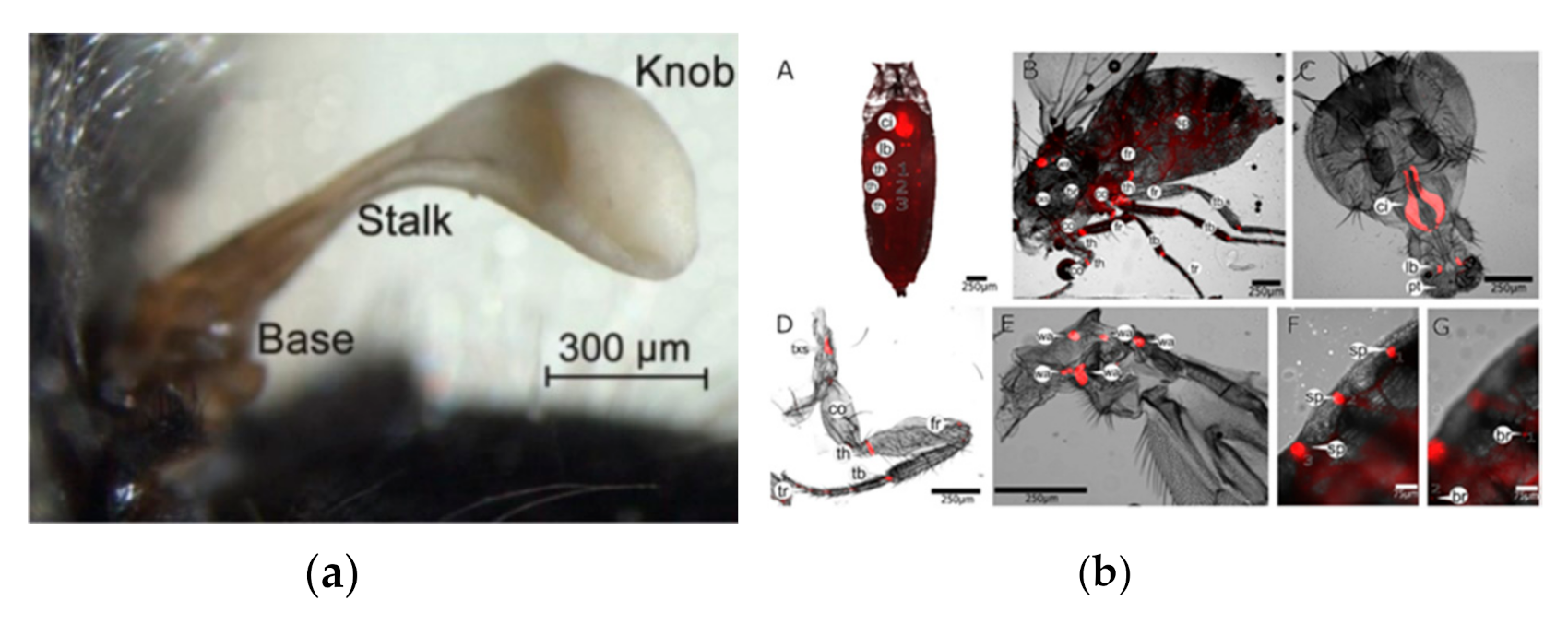

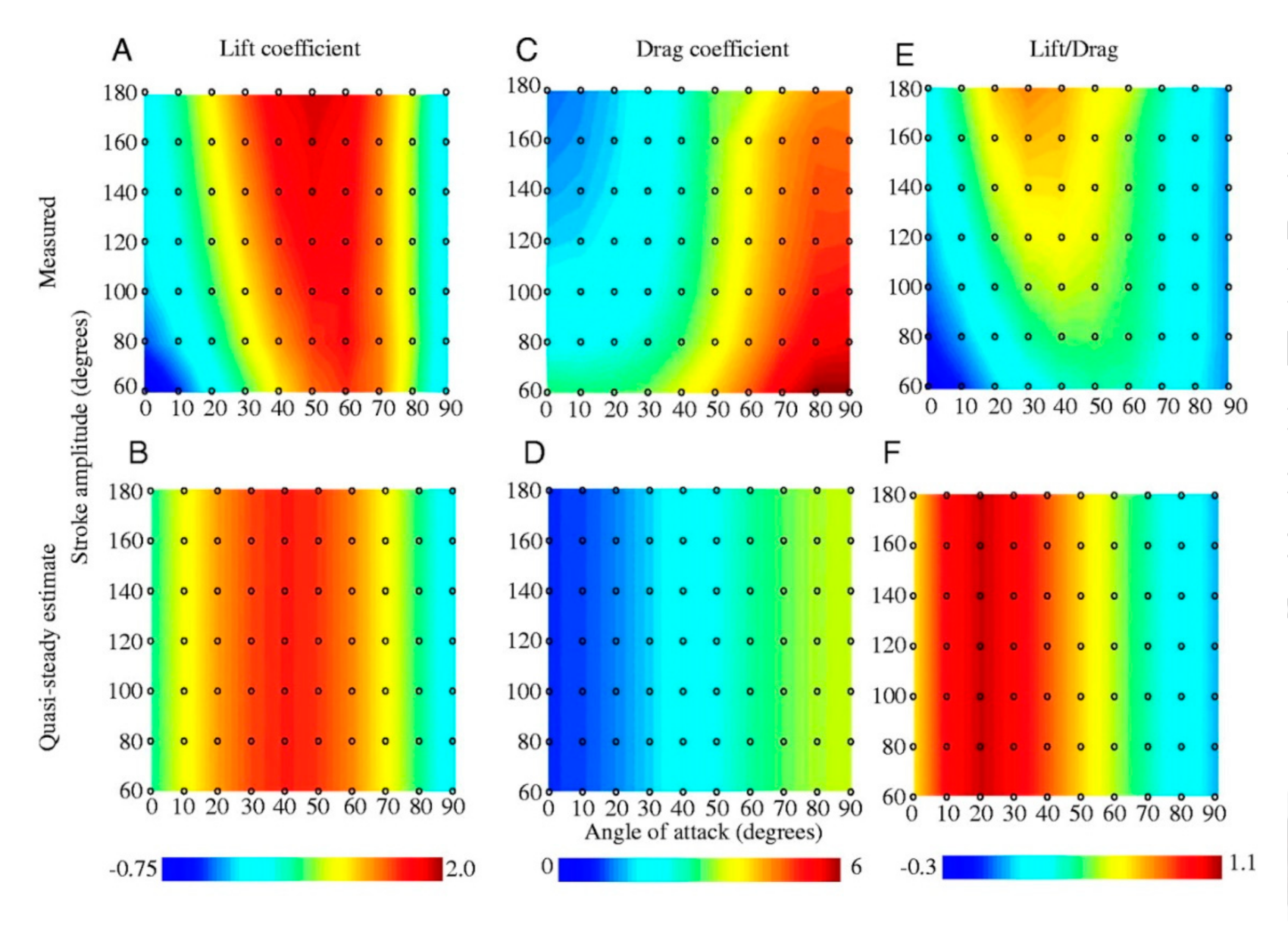
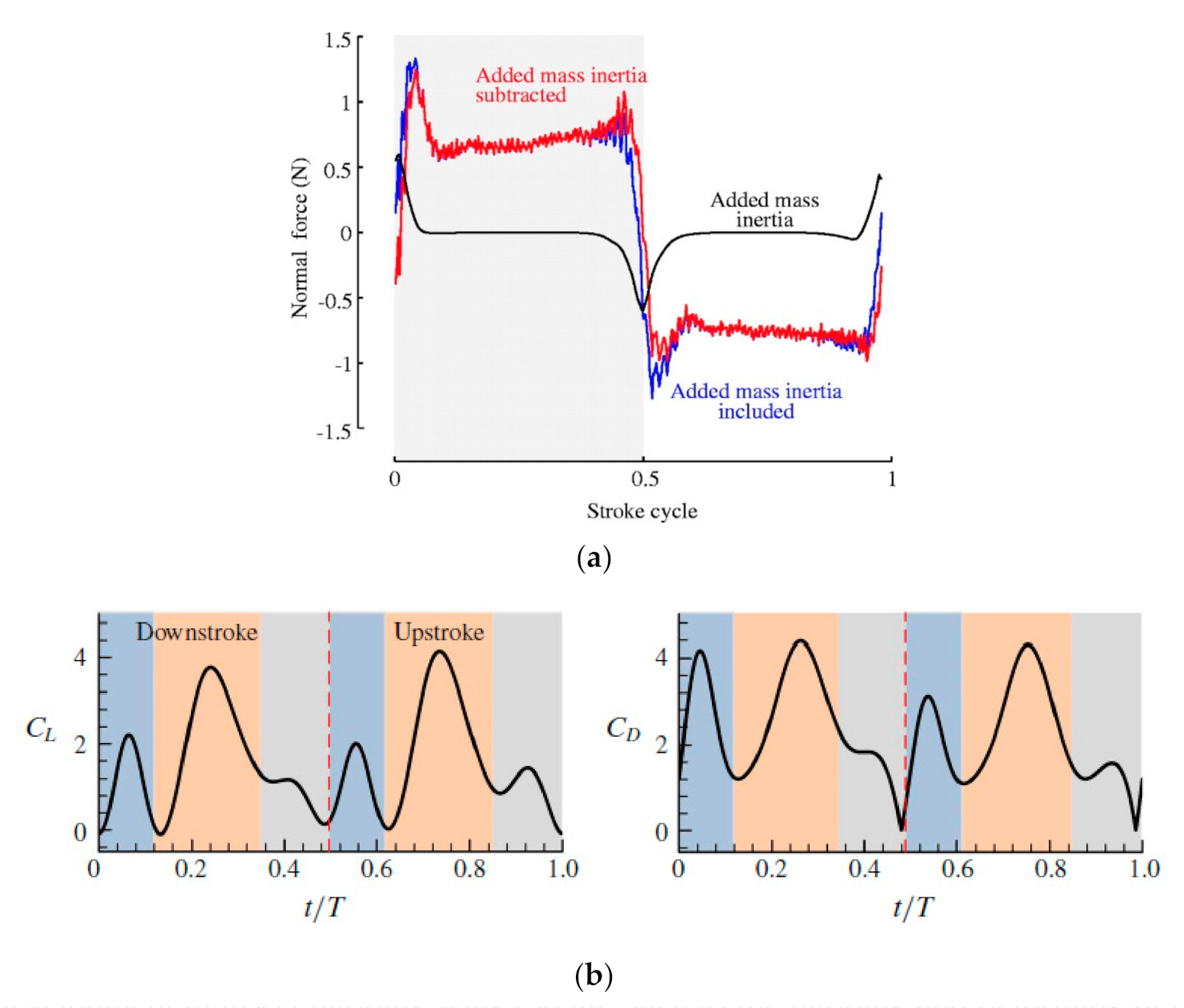
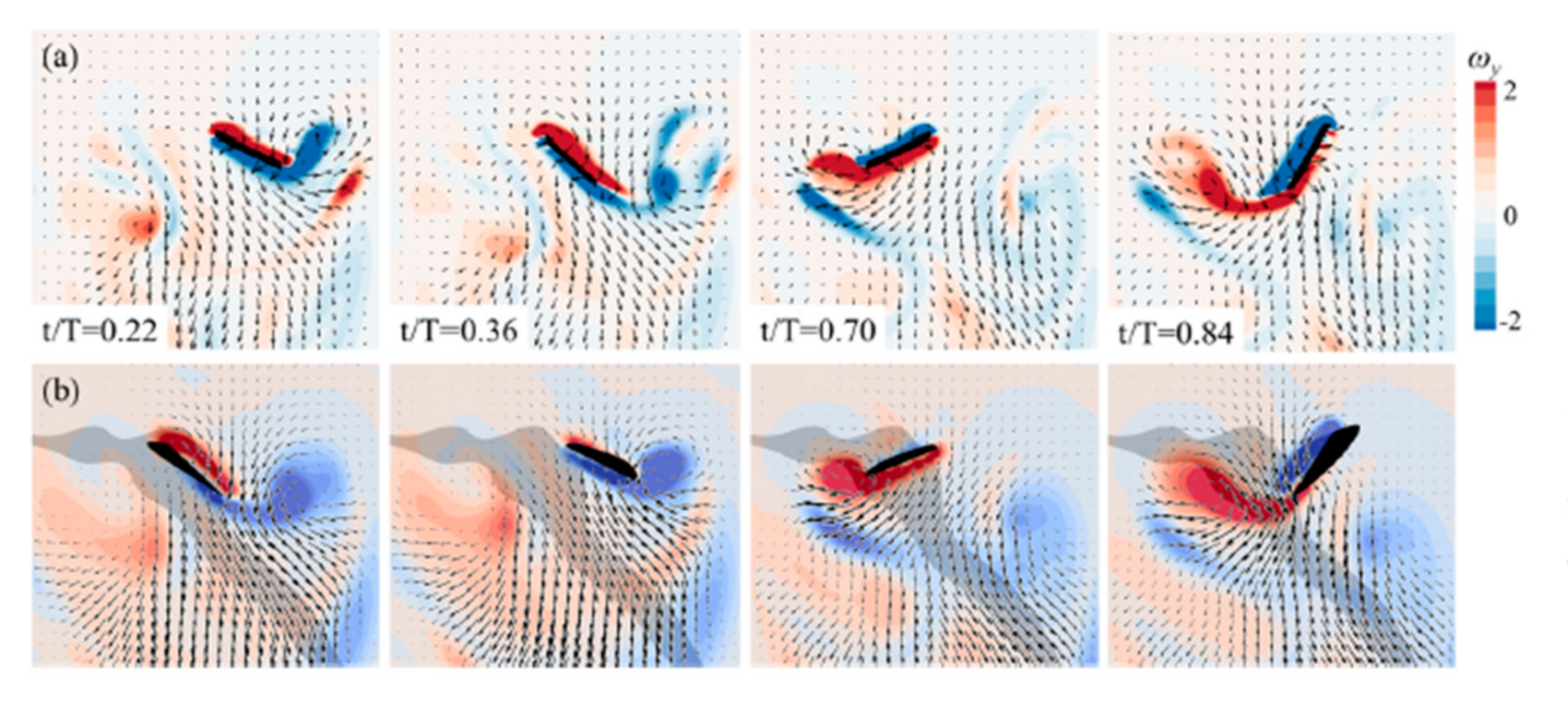

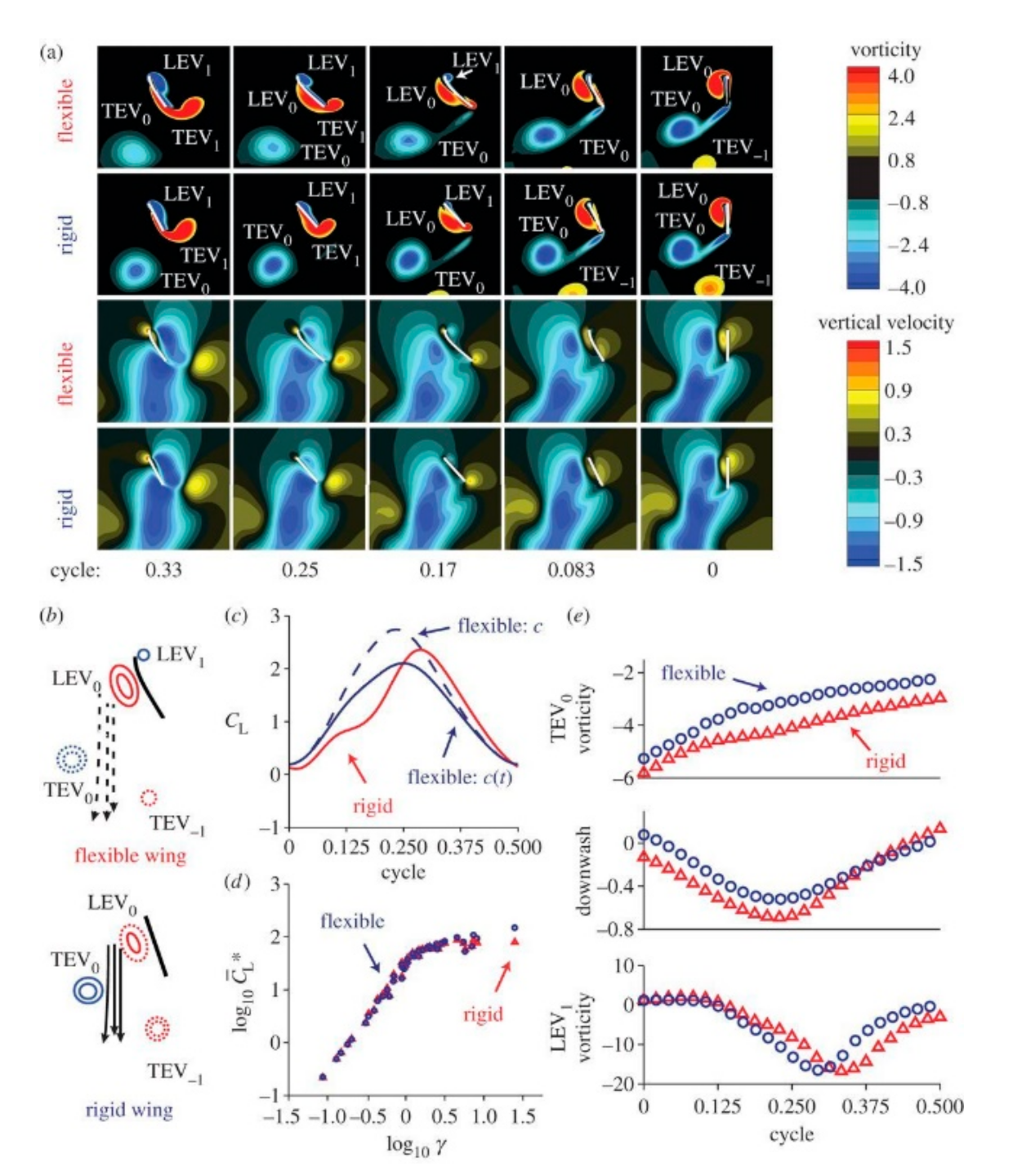
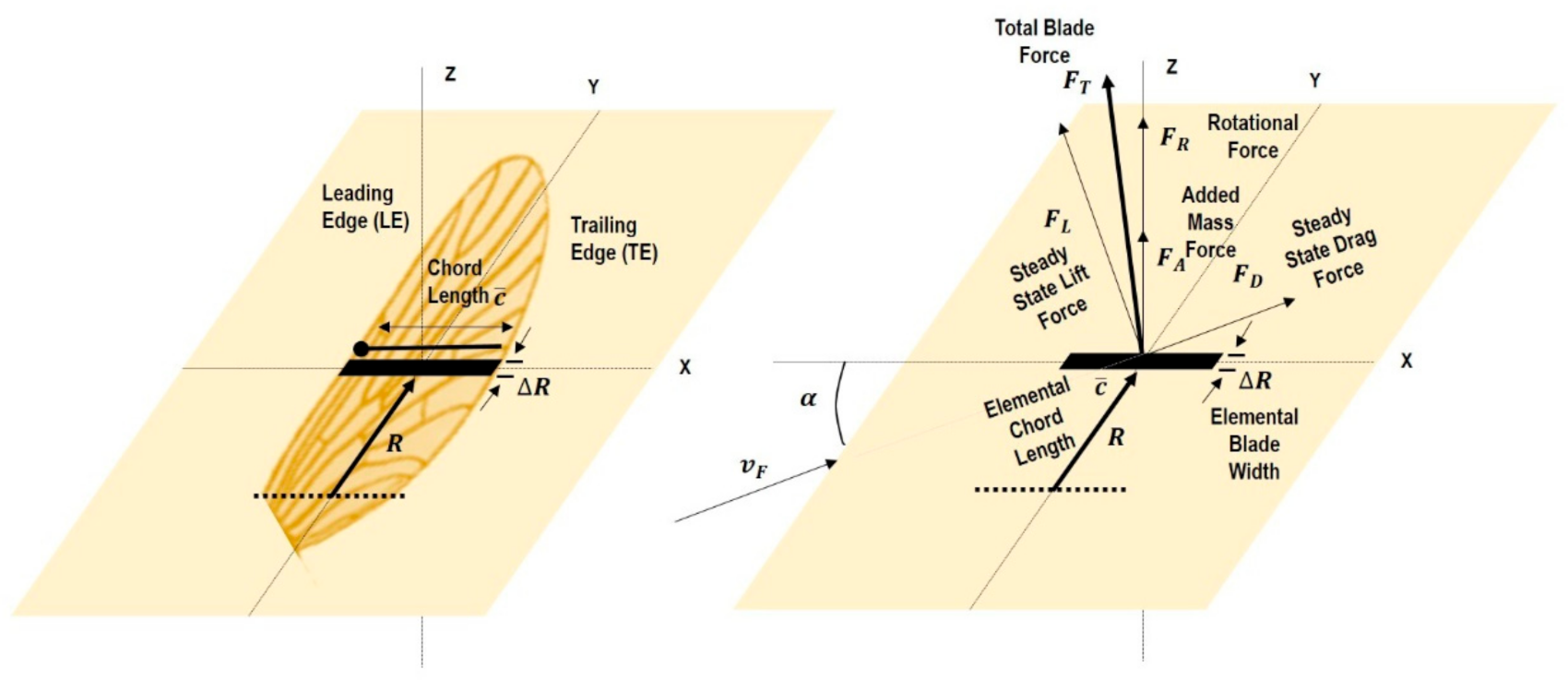
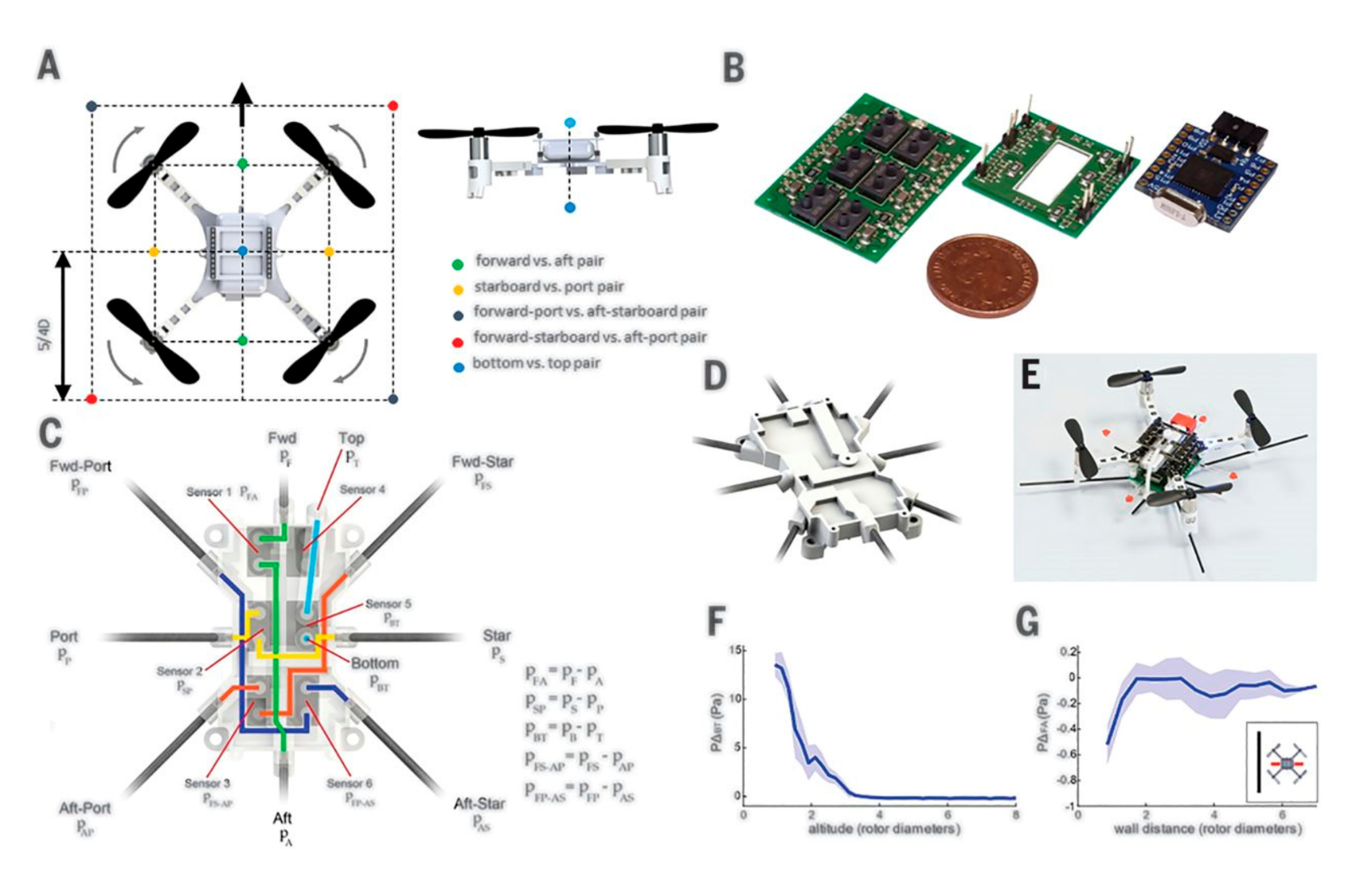
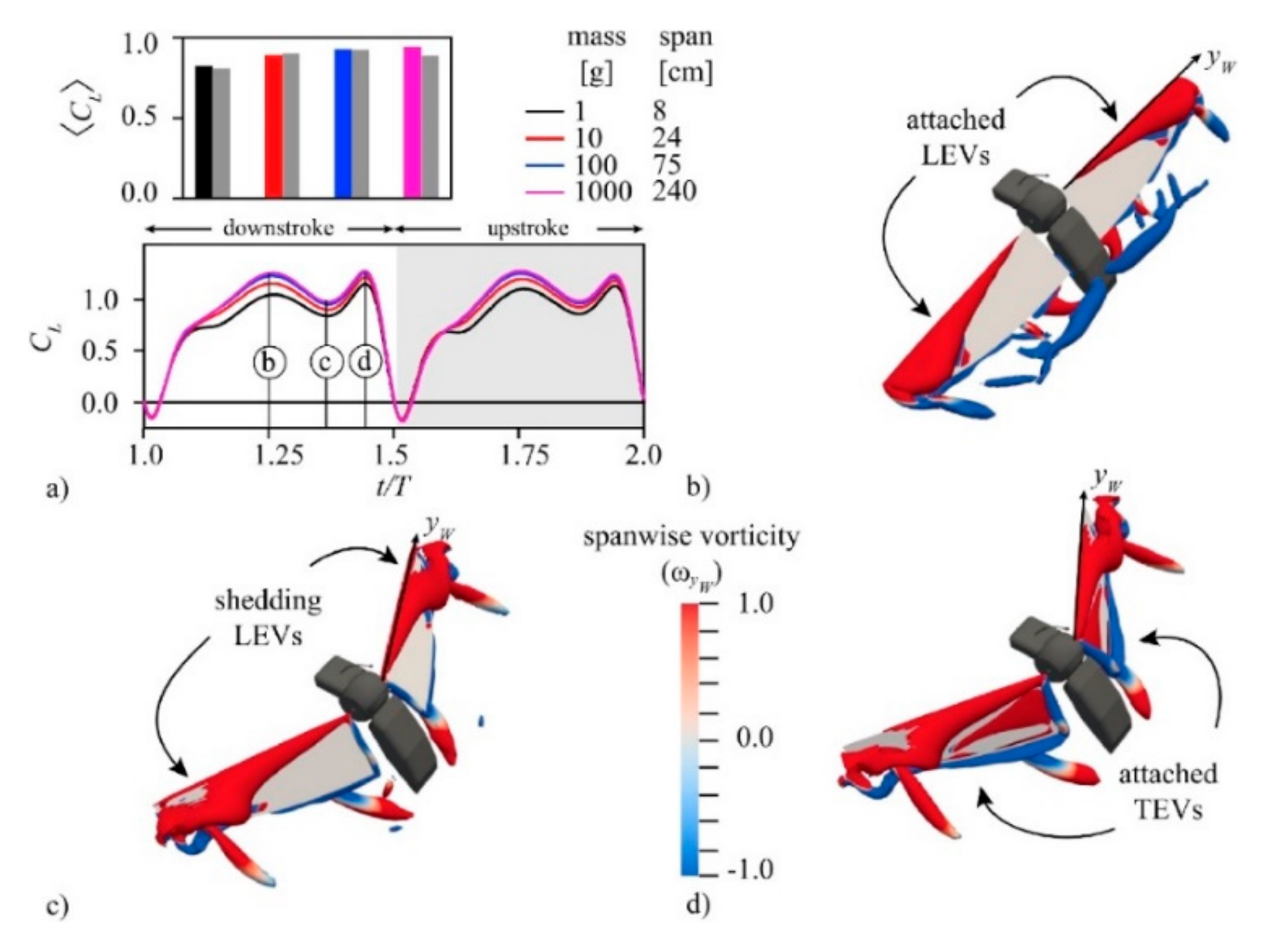

| Flapping Wing System | Year | Developed by | Mass (g) | Wings | Span (mm) | Frequency (Hz) | Actuation System |
|---|---|---|---|---|---|---|---|
| Nao Hummingbird | 2007–11 | AeroVironment Inc. | 19 | 2 | 165 | 30 | DC Motor Driven |
| KU Beetle | 2009–C | Konkuk University | 21.4 | 2 | 160 | 30.5 | DC Motor Driven |
| Pudue Hummingbird | 2011–C | Purdue University | 12 | 2 | 170 | 30–40 | DC Motor Driven |
| 3D Printed Mech Insect | 2011 | Cornell University | 3.89 | 4-X | 143 | 30 | DC Motor Driven |
| Dipteran | 2014 | NTU Singapore | 3.51 | 2 | 100 | 33 | DC Motor Driven |
| KULibre | 2015–16 | KU Leuven | 3.39 | 2 | 50 | 40 | DC Motor Driven |
| MFI | 2001–07 | UC Berkeley | 0.1 | 2 | 25 | 100–275 | Piezoelectric |
| RoboBee | 2007–C | Harvard University | 0.1 | 2 | 30 | 110–120 | Piezoelectric |
| FW-MAV | 2011 | Air force Tech | 0.35 | 2 | 70 | 30 | Piezoelectric |
| Insect Inspired F-MAV | 2012 | US Army Res Lab | 0.03 | 2 | 2.5 * | 156 | Piezoelectric |
| LionFly | 2013 | Penn State, USA | 0.112 | 2 | 45.78 | 37 | Piezoelectric |
| Insect FW Robot | 2017 | S Jiao Tong University | 0.084 | 2 | 35 | 100 | Piezoelectric |
| Bioinspired FWMAV | 2018 | Toyota R&D Labs | 0.598 | 2 | 114 | 120 | Piezoelectric |
| RoboFly | 2018 | UoW, Washington | 0.19 | 2 | 13 * | 170 | Piezoelectric |
| RoboBee | 2019 | Harvard University | 0.09 | 4-X | 35 | 200 | Piezoelectric |
| OVMI | 2008–C | Valenciennes Univ | 0.022 | 2 | 35 | 80 | Electromagnetic |
| FW-MAV | 2011 | KAIST, South Korea | 2.86 | 2 | 75 | 68 | Electromagnetic |
| FW-MAV | 2013–16 | Purdue University | 4 | 2 | 86 | 90 | Electromagnetic |
| FW-MAV | 2017 | Beihang University | 0.093 | 2 | 30 | 101.4 | Electromagnetic |
| Flapping Wing Platform | 2018 | Beihang University | 0.05 | 2 | 56 | 35 | Electrostatic |
| Name of the Insect | Average Weight (mg) | Re | Aspect Ratio | Flapping Frequency (Hz) | Wing Stroke Amplitude | References | |
|---|---|---|---|---|---|---|---|
| Mosquito | 2.1 | 120 | 4.2 | 600–800 | ~0.559 * | 44° | [2,28] |
| Fruit fly | 0.96 | 130 | 2.7 | 218 | 0.212 | 140° | [2,29,30] |
| Honeybee | 86 | 1100 | 3.2 | ~240 | 0.244 | 91° | [2,30,31] |
| Hawkmoth | 1600 | 6100 | 2.7 | 26.1 | 0.298 | 116° | [2,30,32] |
Publisher’s Note: MDPI stays neutral with regard to jurisdictional claims in published maps and institutional affiliations. |
© 2021 by the authors. Licensee MDPI, Basel, Switzerland. This article is an open access article distributed under the terms and conditions of the Creative Commons Attribution (CC BY) license (https://creativecommons.org/licenses/by/4.0/).
Share and Cite
Singh, B.; Yidris, N.; Basri, A.A.; Pai, R.; Ahmad, K.A. Study of Mosquito Aerodynamics for Imitation as a Small Robot and Flight in a Low-Density Environment. Micromachines 2021, 12, 511. https://doi.org/10.3390/mi12050511
Singh B, Yidris N, Basri AA, Pai R, Ahmad KA. Study of Mosquito Aerodynamics for Imitation as a Small Robot and Flight in a Low-Density Environment. Micromachines. 2021; 12(5):511. https://doi.org/10.3390/mi12050511
Chicago/Turabian StyleSingh, Balbir, Noorfaizal Yidris, Adi Azriff Basri, Raghuvir Pai, and Kamarul Arifin Ahmad. 2021. "Study of Mosquito Aerodynamics for Imitation as a Small Robot and Flight in a Low-Density Environment" Micromachines 12, no. 5: 511. https://doi.org/10.3390/mi12050511
APA StyleSingh, B., Yidris, N., Basri, A. A., Pai, R., & Ahmad, K. A. (2021). Study of Mosquito Aerodynamics for Imitation as a Small Robot and Flight in a Low-Density Environment. Micromachines, 12(5), 511. https://doi.org/10.3390/mi12050511








